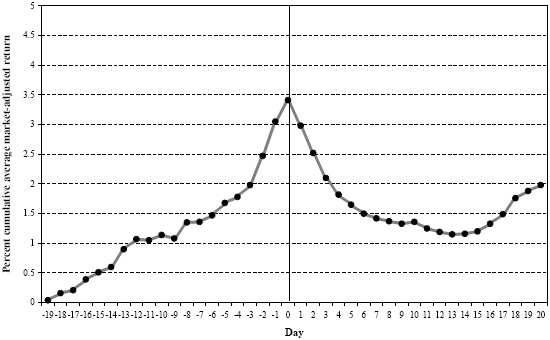Do the attention-grabbing past returns of high-flying stocks produce pre-earnings announcement buying frenzies? In the April 2008 version of their paper entitled “Limited Attention and the Earnings Announcement Returns of Past Stock Market Winners”, David Aboody, Reuven Lehavy and Brett Trueman examine whether the limited time and resources of small investors explains a striking return pattern around the earnings releases of firms with extremely strong prior year price momentum. Using daily stock return data and earnings release/forecast news from the beginning of 1971 through the third quarter of 2005 for a broad sample of companies, they conclude that:
- Stocks in the top 1% of prior year returns generate an average market-adjusted return of +1.58% (-1.86%) during the five trading days before (after) earnings announcements, excluding trading frictions.
- Within this set of high-fliers, stocks with earnings announcements unambiguously occurring outside of normal trading hours generate an average market-adjusted return of +3.09% (-3.05%) during the five trading days before (after) earnings announcements, including a significant close-to-open average return of +0.93% immediately after announcements as part of the pre-announcement return. In other words, going long these stocks five days before earnings announcements, closing the long positions at the first open after announcements and then shorting until the close five days later generates an average market-adjusted ten-day return of over 6%, excluding trading frictions.
- Assuming that all buys are at the ask and sells are at the bid to account for bid-ask spread reduces the above average abnormal returns to +0.94% (-0.85%) before (after) earnings announcements for all stocks in the top 1% of positive momentum and +1.66% (-1.34%) for the subset of these stocks with announcements clearly occurring outside of normal trading hours.
- Fore comparison, the average five-day pre-announcement (post-announcement) market-adjusted return for the entire sample of stocks is just +0.30% (-0.1%).
- Neither contemporaneous pre-release/post-release analyst earnings forecast revisions nor negative earnings surprises explain the anomalous returns.
- There is evidence of a pre-announcement order imbalance for small and medium-sized traders that disappears post-announcement, suggesting that trading decisions of individual investors drive the anomaly.
The following chart, taken from the paper, shows the cumulative average market-adjusted return for stocks in the top 1% of prior year raw returns from 19 days before earnings announcements (-19) to 20 days after earnings announcements (+20) over the entire sample period. Day 0 is the earnings announcement day. The mean daily market-adjusted return is:
- +0.11% from days -19 through -5;
- +0.35% from days -4 through 0
- -0.35% for days 1 through 5;
- -0.06% for days 6 through 13; and,
- +0.12% for days 14 through 20.
The 1.98% cumulative average market-adjusted return over the entire 40-day period represents a momentum return of about 1% per month.

In summary, traders may be able to exploit an attention-driven anomaly for very high momentum stocks by going long from five days before to the morning after earnings announcement and short the next five days.